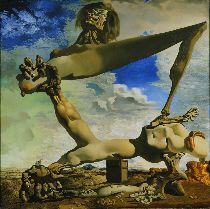
Like Libby said in her post, the Dali blockbuster exhibit at the PMA is a great old show. It brings together works by the Surrealist from collections all over the world and sets them out to tell a big story — of an ambitious artist who at his core was an iconoclast and is more influential today than we know. Early, late and in-between, Salvador Dali was breaking tabus, showing religious imagery in a context of sex and death — and, in fact, everything in a context of sex and death. (The guy famously was fixated on Millet‘s “The Angelus” and imagined the imagery of peasants praying in the field as a scene of sexual submission and dominance. (Think wheelbarrow….) And while he’s not winking, he is a consumate Freudian thinker and having fun with his many subtexts. (top image is one of Dali’s best-known works about the Spanish Civil War, “Soft Construction with Boiled Beans: Premonition of Civil War” (1936))
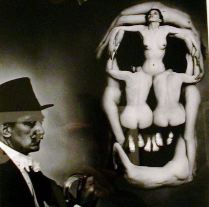
Dali is known for his shenanigans in the public eye (a handsome, photogenic guy, he loved to pose for photographers and was Time magazine’s cover boy, Dec. 14, 1936). In his time, he was known for marching to his own drum beat on politics as well. While the Surrealists, with whom he was allied, were stridently anti-clerical, he hewed to a softer position, not rejecting religion but studying it and making use of it in his works. (Late in life, he came back to Catholicism and even met with the Pope.)
(image is Dali posing with nudes in “In Voluptus Mors” (1951), photo by Phillipe Halsman)
He also distanced himself from the loud anti-Hitler manifestoes of the Surrealists. He was certainly not a fascist or pro-Hitler but like with the church, he was interested in studying the phenomenon.
This adherence to his own political and religious positions coupled with his public persona made him anathema to the Surrealist movement which ultimately kicked him out. But really, Dali’s Barnum-esque showmanship was ahead of its time, paving the way for artists like Andy Warhol, Jeff Koons even Matthew Barney and saving them from having to explain themselves.
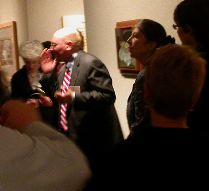
Marcel Duchamp, not a Surrealist but a Dadaist and himself a radical free-thinker, was fascinated by Dali according to PMA Curator of Modern Art, Michael Taylor, who gave the press walk-through accompanied by Dawn Ades, British professor of art history at Essex and a Dali specialist. (Taylor, left, whispering, and Ades, to his right, co-curated the exhibit with help from Montse Aguer.) While the Surrealists rejected Dali, Duchamp did not. Apparently Duchamp organized an exhibition of Surrealist art in New York and included works by Dali. When some of the Surrealists complained, Taylor said, Duchamp told them to “Piss off.” The show went on, and Dali’s work was a great public success.
(Here an aside about the PMA and this show. PMA has a fondness for all things Duchamp, being the repository of perhaps the best collection of Duchamp’s works anywhere, including the “Large Glass,” “Nude Descending a Staircase” and “Etante Donne.” Some of the Duchamp pieces came to the PMA from the collectors Walter and Louise Arensberg. Duchamp assisted the Arensberg’s in collecting art and presumably helped steer the collectors to their purchase of one of Dali’s premier works, “Soft Construction with Boiled Beans: Premonition of Civil War” (1936) (top image), which is now in the PMA’s collection and a highlight of this exhibit.)
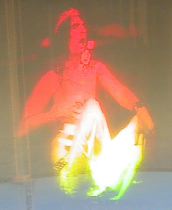
Dali felt kinship with all extreme artistic types and outsiders. He was a friend of wild man, Harpo Marx, for example, and the show includes a small drawing Dali did of the comic. In addition, the artist was a bold experimenter with techniques — and the exhibiton includes amazing pre-Pop paintings (think Lichtenstein’s Ben Day dots) and, the first-ever art hologram, Dali’s bare-chested Alice Cooper whose ghostly image spins in a plastic box towards the end of the installation.
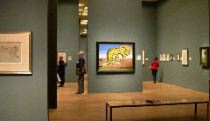
Anyway, that’s enough wind out of me about the great show. (I’ll save some hot air for my PW coverage.) But I will say that the large exhibit (more than 200 works!!!) is housed beautifully at the PMA, with dusky, grey-green and plum-colored walls, nice groupings and single floating walls to show a singular blockbuster work (image). The galleries are not large and the works are plentiful and some are quite small, so beware of crowds. And know that you must check your coat and any large bags (bigger than 10″ by 12″!) and will not be allowed to sketch or photograph anything. Also, the audio tour, which is free with the ticket, may result in clogged arteries around some of the works.
This centennial exhibition of Dali’s works was organized by two institutions: the PMA and the Palazzo Grassi, Venice, in collaboration with the Gala-Salvador Dali Foundation in Figueres, Spain. Philadelphia is the show’s only US stop. It was previously shown in Venice. For a nice preview of the show, check the PMA link at the top of this post for a great curator’s walk-through by Michael Taylor — click explore the exhibition at bottom of the list of options.dali, salvador









